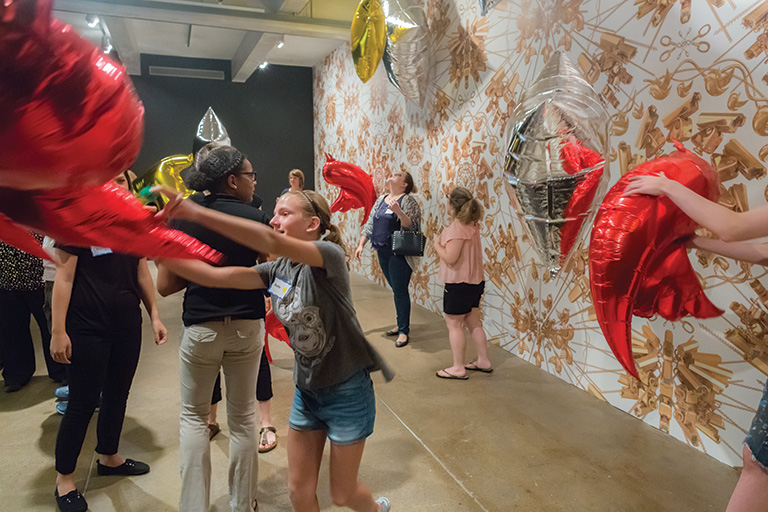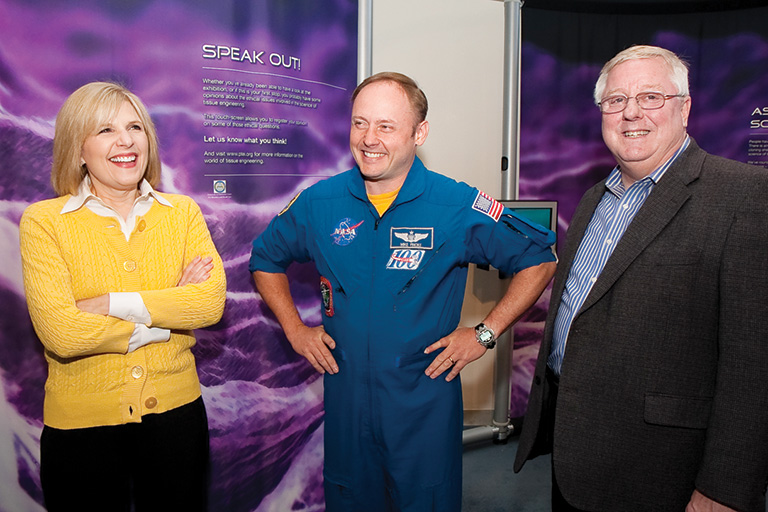Museums: Just what the doctor ordered

Teens explore The Warhol during a sensory-friendly event. Photo: Renee Rosensteel
In programs for visitors living with autism spectrum disorders, trauma, and dementia, educators at Carnegie Museum of Art and The Warhol witness firsthand the therapeutic effect art has on visitors’ lives. And someday soon, physicians may even be able to prescribe free museum visits for patients suffering from a host of ailments, from diabetes to depression.
As part of a yearlong pilot program with the Montreal Museum of Fine Arts, a group of Canadian doctors will soon have the option to treat patients with a day filled with art and escapism. “It’s so rare in medicine that you prescribe something and you don’t need to worry about side effects or interactions with other medication,” said Dr. Hélène Boyer, vice president of Francophone Doctors of Canada, to the Montreal Gazette. The boost in hormones associated with visiting an art museum, she explained, is similar to that offered by exercise, making museum prescriptions ideal for the aging and those who are experiencing life-threatening diseases or chronic pain. The Canadian museum is involved in 10 clinical trials assessing the impact of art on people with eating disorders, breast cancer, epilepsy, mental illness, and Alzheimer’s disease. In this latest program, doctors can issue up to 50 prescriptions granting admission to the museum for a family of four.
Cemented in history

All 80 original homes are still standing in Donora’s historic Cement City, a Mon Valley neighborhood of 1916–17 prairie-style houses made of concrete. Models of seven of them—six completed and one under construction—are this year’s addition to Carnegie Science Center’s Miniature Railroad & Village. The American Steel and Wire Co. aspired to put up 600 to 800 of the quick and inexpensive company homes designed for middle management and made of concrete—a construction method popularized by Thomas Edison—but halted production due to cost. The Donora neighborhood is the second-largest development of its kind; the biggest is in Gary, Indiana, and includes 110 homes.
“[These birds] have a destiny: they were caught hundreds of years ago on an island, they may have gone extinct since then, and all we have is some feathers, a beak, some feet, some notes. Maybe a recording of their calls, a photograph of their nest. And that’s it.”
– Carnegie Museum of Natural History evolutionary biologist Chase Mendenhall talks with Popular Science about the scientific value of the museum’s bird collection and the challenges of protecting such irreplaceable artifacts in the wake of the devastating fire at Brazil’s National Museum.

Think global, act local

© Zak Noyle/A-Frame
Carnegie Museum of Natural History’s We Are Nature: Living in the Anthropocene left quite an impression on many of its visitors. A group of first- through third-graders from Montessori Children’s Community in Sewickley was so struck by signing a funerary book for the Great Barrier Reef that they took up their own collection to help save it. For James Whitacre, a geographic information system (GIS) research scientist at Powdermill Nature Reserve, the exhibition’s image of a surfer gliding beneath the crest of a debris-littered wave is what stopped him in his tracks. He recalled reading that 10 rivers contribute to nearly 90 percent of all the plastic found in the Earth’s oceans. Even though none of those rivers are in the U.S., it got him thinking: How does Pittsburgh and its three rivers contribute to the plastics epidemic? He’s now asking Pittsburghers to crowdsource data to find out. To participate, the next time you come across plastic waste in your neighborhood or a public park, map it using a GPS-enabled mobile device at https://arcg.is/1OOqrL, and then recycle it if you can. Whitacre says the resulting data could identify local waste hot spots and maybe even help determine what stream it could end up in and what’s the shortest path to the nearest ocean.
9000 MILES

Which artists traveled the farthest to participate in the 57th Carnegie International? Phan Thao-Nguyen, Truong Cong Tung, and Arlette Quynh-Anh Tran of the Ho Chi Minh City-based artist collective Art Labor—nearly 9,000 miles. Pittsburgh-based artist Jon Rubin traveled the shortest distance, exactly 2.4 miles.
A formula for success

Ann Metzger and Ron Baillie with astronaut and Emsworth native Mike Fincke (center).
After a hugely successful decade as co-directors of Carnegie Science Center, Ron Baillie and Ann Metzger recently announced that they’ll retire at the end of December. The pair have a lot to celebrate. The most visible sign of the Science Center’s growth through their leadership is the June opening of the PPG Science Pavilion, the centerpiece of the Science Center’s $46 million SPARK! Campaign. The four-story, 48,000-square-foot expansion has increased the Science Center’s capacity to deliver informal science, technology, engineering, and math (STEM) programs, offer blockbuster touring exhibitions, and host events in a conference and event space overlooking Pittsburgh’s Point. “Ann and Ron have been a mighty force on the North Shore. And it’s through their leadership that the Science Center has realized its vision to become a true leader in STEM learning,” says Kevin Hiles, interim president of Carnegie Museums. Since launching the Center for STEM Education and Career Development in 2011, the Science Center has expanded its award-winning, student-centered programs and competitions and developed the Carnegie STEM Excellence Pathway, a self-evaluation tool that has been adopted by more than 5,000 schools and school districts across the country. An impassioned educator, Baillie’s career with the Science Center and its predecessor, Buhl Planetarium, stretches back a remarkable 35 years. An honored marketing pro, Metzger spent 25 years at the University of Pittsburgh Medical Center before joining Carnegie Science Center as senior director of marketing and community affairs in 2006. Jason Brown, the Science Center’s senior director of science and education, has been picked to serve as interim director, and Kim Amey, senior director of strategic initiatives, will serve as interim deputy director.
Receive more stories in your email
Sign up